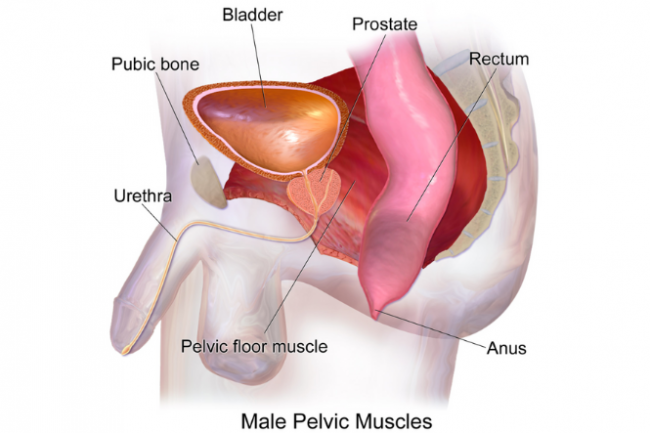Pelvic floor training for men
Key points about pelvic floor training:
- Many men have continence issues after prostate surgery. As men age, erectile dysfunctions can also start to occur.
- These are often related to lack of exercising your pelvic floor muscles, weight gain, and other health issues.
- Pelvic floor muscle weakness and symptoms can be improved with the correct training.
- A pelvic health physiotherapist or continence advisor can check you are doing the exercises correctly, and then design an individual programme tailored for you.
- Improvement in pelvic floor muscle strength will take between 3 and 6 months of regular training of the muscles.

The pelvic floor muscles are a layer of muscles stretching from your pubic bone at the front to your tailbone at the back. They form the floor of your pelvis and support the pelvic organs.
Image credit: BruceBlaus wikimedia
Your pelvic floor muscles help:
- gain and maintain an erection
- support the pelvic organs (bladder and bowel)
- maintain bladder and bowel control and help prevent accidents
- control problems such as frequency and urgency
- empty your bladder and bowel
- contribute to core stability.
Factors contributing to pelvic floor muscle weakness include:
- prostate surgery
- some neurological conditions, eg, stroke or Parkinson's disease
- constipation and straining to empty your bladder or bowel
- persistent heavy lifting
- a chronic cough (from smoking, chronic bronchitis or asthma)
- being overweight
- ageing
- lack of use (not exercising the pelvic floor muscles).
The best results will be achieved by seeking help from a pelvic health physiotherapist or continence advisor. They will assess you individually and design a training programme that is best for you. Strengthening your pelvic floor muscles can take 3–6 months of regular exercises.
The best results will be achieved by seeking help from a physiotherapist (with training in continence) who will design an individual training programme especially suited to you.
Where are my pelvic floor muscles?
The first step is to correctly identify the muscles.
- Sit or lie down on a comfortable surface like your bed.
- Relax your thighs, buttocks, and tummy/puku muscles. Breath normally, don’t hold your breath or change your breathing pattern.
- To get the correct contraction, imagine you trying to hold a fart in by squeezing your back passage closed. Hold this for 5 seconds and then relax your muscles. Alternatively imagine bringing your ‘nuts to guts’ or shortening your penis.
- If you aren't sure if you have found the correct muscles, stand in front of a mirror naked. Do the contraction and watch what happens to your penis and testicles – you should see a small dip above your penis and your testicles should lift up a little bit. You can also place two fingers just under your scrotum on the flat skin and feel for a tightening under your fingers when you do the contraction. If you see the lift or feel the tightening, you are doing the contraction correctly.
If you are unable to feel any definite squeeze and lift action in your pelvic floor muscles, it is important that you seek professional advice from a pelvic health physiotherapist or continence advisor. They can assess you to make sure you are doing the exercises correctly.Here is a directory of pelvic health physiotherapists(external link) in Aotearoa New Zealand.
How should I exercise them?
Do the contraction exercises daily for the best improvement possible. Long contractions of the muscle (up to 10 seconds) combined with short fast contractions (10 times for 1 second) work the best to get your pelvic floor strong with great control. At first you may need to perform these exercises while sitting or lying down. As the muscles strengthen, you can move on to exercising standing up. As with any muscle training activity, start with what you can achieve and progress from there. Over time, increase both how long you hold the contraction for, as well as how many times you repeat the exercise in a row.
Apps reviewed by Healthify
You may find it useful to look at some Pelvic floor exercise apps.
- Keep your weight within a healthy range for your height and age.
- Seek medical advice for chronic cough.
- Develop good bowel habits.
There are health professionals qualified to help you with bladder control problems. Ask your GP for advice.
Pelvic floor training for men(external link) Continence NZ
Pelvic floor disorders(external link) Physiotherapy NZ
Pelvic floor muscles – a patients' guide(external link) Family Doctor NZ
Apps
References
Pelvic floor training for men(external link) Continence NZ
Pelvic floor guide(external link) Continence NZ, 2022
Stafford RE, Ashton-Miller JA, Constantinou C, et al. Pattern of activation of pelvic floor muscles in men differs with verbal instructions(external link) Neurourol Urodyn. 2016;35(4):457-463.
Credits: Healthify editorial team. Healthify is brought to you by Health Navigator Charitable Trust.
Reviewed by: Melissa Davidson, PhD, MPhil, Dip.Physiotherapy, B.Science, Dip.Manipulation, Post Graduate Certificates in Physiotherapy (Pelvic Floor and Acupuncture)
Last reviewed:
Page last updated:





